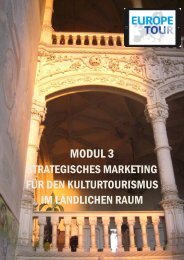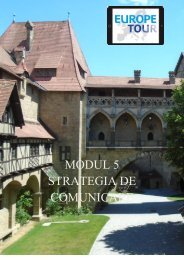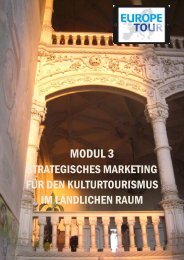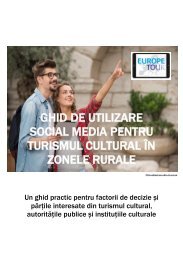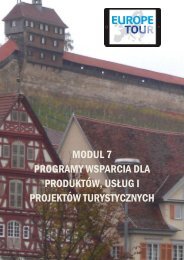Module_3_Marketing_Strategy
You also want an ePaper? Increase the reach of your titles
YUMPU automatically turns print PDFs into web optimized ePapers that Google loves.
CULTURAL TOURISM TRAINING COURSE<br />
MODULE 3 - STRATEGIC MARKETING IN CULTURAL TOURISM<br />
Strategic Objectives in Cultural Tourism<br />
The peculiarity in cultural tourism is that the development of marketing object-tives on the<br />
organisation’s, i.e. on the corporate level, must be embedded into the various levels of the tourism<br />
branch and their national, regional or local tou-rism concepts. These super-ordinated “macro<br />
objectives” set the framework in which you can develop your “micro” objectives, and sometimes they<br />
lead to certain limitations.<br />
A single hotel in a spa would have difficulties if it tries to set a<br />
mar-keting objective to reach young motor bike travellers.<br />
If the regional destination is being marketed under soft tourism,<br />
then the individual providers should arrange for respective operational<br />
targets and offer e.g. ecological hotel management with<br />
electric bike rental.<br />
Members of a touristic association must also respect the<br />
objectives of this umbrella organisation and combine their goal of<br />
profit maximising with the regional goals of e.g. culture tourism<br />
or quality tourism.<br />
Vision statement and mission statement<br />
The development of your strategic objectives is closely linked with your vision and mission.<br />
A vision statement is an exciting picture of your organisation’s desired future which intends to motivate<br />
all collaborators to work together to achieve this future. Visioning is most successful when it is<br />
participatory and when it creates an image that integrates all the separate visions of people involved.<br />
In order for a vision to mobilize resources — which is the ultimate purpose of a vision — it must find<br />
common, higher ground in everybody who sees it as part of his/her future. Only then, a strong vision<br />
can motivate people to work together to achieve what otherwise might be unachievable.<br />
Unfortunately, very often many visions contain only short, bland, meaningless mix-tures of key words<br />
which have been contributed by the different participants. As a result, no one can identify with such<br />
sterile statement and it fails as a project development tool.<br />
19




